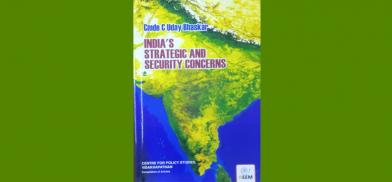India’s security and foreign policymaking has become more assertive, muscular
India’s Strategic and Security Concerns by Cmde C Uday Bhaskar. Published by Centre for Policy Studies; Reem Wisdom, New Delhi; 2020; Pages 179; Rs. 795

Numerous factors contribute to the making of a country’s security and strategic policy. Like other ancient civilizations, modern India’s national security and foreign policymaking has been shaped and influenced by its geographical, historical, cultural and social experiences. The abiding principle of India’s security doctrine has been a commitment to retaining its strategic autonomy, that is, the right to free will, and to act without being pressured by alignments and obligations to abide by your values and actions.
But if any one issue can be named that has influenced Indian strategic thinking, it has been it's abiding as well as changing domestic political compulsions. Over the decades, therefore, a nuanced shift has been observed in its national security planning. Guided by a post-independence, freedom fighting, elite leadership which adopted a more defensive, non-aligned direction in their foreign and security policy, India’s current leadership is more confident and assertive, even muscular on occasion, orientation is reflective of the changes in policymaking that have taken place in the domestic environment.
India’s Strategic and Security Concerns, a compilation of opinion/analysis articles written over a decade for the media, journals, and websites by Commodore C Uday Bhaskar (retd), and published by the Centre for Policy Studies, Vishakhapatnam is almost like a chronicle of the issues and events that took place over a decade, but with deep insight and analysis. The fact that the Centre thought it fit to put together Cmde Bhaskar’s thoughts and opinions are indicative of the author’s standing in the strategic community.
I remember as a young researcher in the Institute for Defence Studies and Analyses (IDSA) - the Institute has been recently renamed as the Manohar Parrikar Institute of Defence Studies and Analyses - I was perpetually awed, even envious, at the depth and spread of Cmde. Bhaskar’s knowledge and insight into strategic affairs, not to mention his impressive public speaking skills. I was therefore elated to see the same articulation, chapter after chapter, in this slim volume, despite its 36 articles plus four obits. The fact that all the articles are short and pithy, makes for an easy and pleasurable read, written as they are in the author’s inimitable style.
Divided into four sections, the first section, the introduction, comprises some personal reflections as well as the author’s views on India’s strategic culture and some big-ticket events that changed the direction of international relations in the post-Cold War era. The first chapter, a personal recollection of the author’s tenure at IDSA, “a hub for garnering and sharing news” as the author puts it succinctly and written as a contribution to a special issue of the Institute’s 50th anniversary in 2015, will hold a special significance for all readers who have been associated with IDSA at some time. But it also sets the mood for the rest of the articles in the book, covering a range of developments encompassing the era when events like the Soviet withdrawal from Afghanistan that heralded the beginning of the end of the Cold War, Tiananmen, the fall of the Berlin Wall, and the first Gulf War of 1990 that was world-changing in their impact.
The next section, on National Security, is dominated by issues like defence budget, domestic security, and strategic challenges and imperatives and civil-military relations. The fact that the author had a ringside view of the events and had first-hand knowledge and access to the persons who actually contributed to many of the policies that were implemented, both in India and other countries provide a fascinating insight into the factors that led to some of the decisions taken, however incomprehensible they may have seemed at the time. Indeed, perhaps having had a ringside view of events and the decision-making process, Bhaskar is the right person to have come to the conclusion – and he is certainly no exception – that “domain competence has been the least of the considerations for managing national defence.” For a man, who is known for always being restrained, even understated, in his opinion, even when he is being critical, he is uncharacteristically unambiguous when expressing his views on civil-military relations, in chapters 2, 11, 12 and 16. In fact, the articles in the volume on this issue are some of the most hard-hitting and clearly something he feels deeply about. His overt criticism of the bureaucratic set-up of the defence ministry will, I have no doubt, resonate with the uniformed constituency in the defence establishment, especially when he states that the result has been that the apathy and the indifference of the civilian constituency has been the extended neglect of the ‘fauj’ (army).
Interestingly, however, and notwithstanding his career as a naval officer, there are few articles – only chapters 22 and 32 – that focus on India’s maritime security. In both, he reiterates the point that despite the immense potential to be a major maritime power, for a variety of reasons, “India has not been able to enhance its comprehensive maritime capability in an appropriate manner”.
It is, however, in the third section, foreign relations and global affairs, where the author comes into his own. While he very effectively draws linkages between domestic compulsions pushing policy in external relations, his articles on international politics and foreign policymaking are the most insightful. Comprising of 17 chapters/articles, all delightfully brief but succinct, the reader gets a panoramic overview of events that dictated and influenced current world relations, such as 9/11 that “ostensibly changed the world”; the rise of the non-state actor as a global phenomenon; nuclear relations and politics between India and countries like China, Japan and the US, the significance of Chinese President Xi Jinping’s ascent and Sino-Pak relations; the story of the changing India-US dynamics, and many, many more. While most of these have been told and retold by innumerable strategic analysts, what sets these articles apart is the artful weaving of theoretical with the empirical narrative with insightful finesse.
Of special significance is the author’s take on India-US and India-Russia relations covered in Chapter 24. He correctly opines that a robust relationship with the US is more critical for India than it is for the US, which needs to be internalised in the Indian polity. He lauds the National Democratic Alliance (NDA) government for recognising and acting on this reality, unlike the previous United Progressive Alliance (UPA) government which attempted to “advance the relationship by stealth”. At the same time, he astutely states that it would be misleading to infer that for India a more robust relationship with the US is a binary choice that will come at the expense of Moscow. In his characteristically sophisticated and subtle style, he writes that the “current dynamic of globalisation impels wide-spectrum engagement and subsumes complex contradictions,” and offers the Japan-China relationship as an example.
The final section, the briefest, comprises (obits) tributes to four personalities who clearly left a deep impression on the author. My personal favourite is the first, a tribute to former Prime Minister PV Narasimha Rao, whose contribution to India’s economic and foreign policy is only now being acknowledged. The fact that this tribute was written as far back as 2007 when even the former PM’s own party was chary of giving him the recognition he deserved, speaks volumes. The other three are dedicated to Marshal of the Air Force Arjan Singh, Field Marshal Maneckshaw, and, interestingly, S R Nathan, the former Singaporean president, who the author claims was one of the architects of India’s relations with the Association of Southeast Asian Nations (ASEAN), and whom he knew personally. While these tributes provide fascinating insights into these formidable personalities and their contributions to strategic events, one may question their inclusion in this volume.
All in all, this slim volume is a must-read for scholars and those working on the strategic and security issues, as it provides valuable insights into the incidents and circumstances that contributed to policymaking. As the author himself puts it: 25 years later (from the time he was a part of IDSA), there is a sense of déjà vu about the first major India-US Track II that the author personally observed from close quarters that characterised the deliberations in 1990 which were as visible in 2015. In other words, the more things change, the more they remain the same.
(The writer is a Delhi-based energy security and strategic affairs consultant and commentator. She can be contacted at srdadwal@gmail.com)










Post a Comment